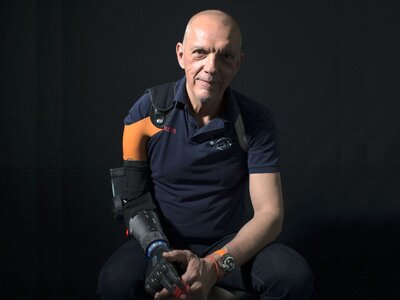
ARM / Arm Prosthesis Race

SmartArM ARM
France
About the Team
Smart ArM team is a research team from Sorbonne Université in Paris, France, specialised in arm prostheses for transhumeral amputees, i.e. above the elbow. This team was created by Nathanaël Jarrassé, CNRS research fellow in the AGATHE team of ISIR and specialist in rehabilitation and assistance robotics. It is composed of about fifteen scientists from the field of robotics or neurosciences, supported by a group of MDs from the equipment department of the IRR of Nancy (UGECAM Nord-Est). The SAM team which already participated in the CYBATHLON 2020 Global Edition, the CYBATHLON 2022 Challenges (winner) and 2023 Challenges is one of the only teams of the ARM race to have a pilot with a missing forearm. During the competition, the team will present a prototype of a very advanced arm prosthesis (elbow, wrist and hand), the result of several years of research at ISIR, and whose control, recently patented, is among other approaches based on the decoding of whole body movement strategies in humans. One major objective of team SmartArM is not only to focus on pure task performance but rather to aim at restoring elegant movements with the prosthesis.
SmartArM ARM

About the Pilot
Christophe Huchet was the official pilot of the Smart ArM team for the CYBATHLON 2020 Global Edition. He was born with an agenesis of the right arm including the elbow. While studying business, he began a career as a swimmer. Many times, French Champion of 100-meter breaststroke races, in the handisport section, it is however in the valid section that he is the happiest to make finals and podiums. He also obtained to have the FFN rules modified, which regularly disqualified him for not touching the wall with both hands! Over the last 20 years, Christophe has created several restaurants in Paris, that he recently sold in order to resume his studies and become a certified coach. His goal is to guide the managers of small and medium-sized companies, as well as he had been guided as a company manager himself. His participation since 2020 in the different CYBATHLON events has been a new adventure that provided him with a rich and intense year.
About the Device
SAM (Smart ArM) is an arm prosthesis dedicated to transhumeral (above-elbow) amputees or congenital amputees without a forearm. It offers patients intuitive and efficient control approaches, in order to extend their motor abilities and increase their autonomy when performing Activities of Daily Living.
The goal of SAM is to draw specific attention to the complex case of the “above-the-elbow” amputation level and its particularities. Indeed, transhumeral or congenital amputees who need elbow prostheses have to deal with the complex control of at least two active joints (on which little research is conducted) in addition to hand control. SAM also wants to promote the possibilities offered by non-invasive approaches, in reaction to the recent trends in invasive and surgical techniques (implanted electrodes, muscle reinnervation, etc.).
SAM possesses two motorized degrees of freedom: an active robotised wrist rotator, and an original exoskeletal active elbow especially designed for congenital amputees (missing a forearm and an elbow joint) who usually have long arm residual limb. Moreover, SAM can be fitted with any commercially available prosthetic hand.
The main innovation in SAM is not only in the hardware but rather in the embedded control architecture and the associated sensorimotor control policies that we have been working on for several years. Our innovative control strategy relies on two different control modes:
– control based on the decoding of myoelectric contraction patterns associated with the voluntary contraction of residual muscles in arm amputees, measured with sEMG electrodes placed within the prosthesis socket.
– control based on the body and residual limb movements of the user measured with embedded wearable inertial measurement units (IMUs). This control mode essentially relies on body compensatory strategies, in order to coordinate some of the movements of the intermediate prosthetic joints and thus achieve faster reactions and more biomimetic gestures.
These control modes can be coupled together (some joints being controlled by one mode, while some others by the other mode) to enhance the dexterity of its wearer.


